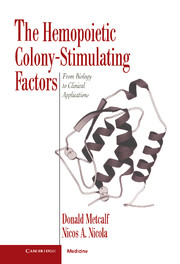Book contents
- Frontmatter
- Contents
- Preface
- 1 Historical introduction
- 2 General introduction to hemopoiesis
- 3 Key techniques in analyzing hemopoiesis
- 4 Biochemistry of the colony-stimulating factors
- 5 Biochemistry of the colony-stimulating factor receptors
- 6 Molecular genetics of the colony-stimulating factors and their receptors
- 7 Biological actions of the colony-stimulating factors in vitro
- 8 The biology of colony-stimulating factor production, degradation, and clearance
- 9 Actions of the colony-stimulating factors in vivo
- 10 Role of the colony-stimulating factors in basal hemopoiesis
- 11 Actions of the colony-stimulating factors in resistance to infections
- 12 Role of the colony-stimulating factors in other disease states
- 13 The colony-stimulating factors and myeloid leukemia
- 14 Clinical uses of the colony-stimulating factors
- 15 Conclusions
- References
- Index
15 - Conclusions
Published online by Cambridge University Press: 04 August 2010
- Frontmatter
- Contents
- Preface
- 1 Historical introduction
- 2 General introduction to hemopoiesis
- 3 Key techniques in analyzing hemopoiesis
- 4 Biochemistry of the colony-stimulating factors
- 5 Biochemistry of the colony-stimulating factor receptors
- 6 Molecular genetics of the colony-stimulating factors and their receptors
- 7 Biological actions of the colony-stimulating factors in vitro
- 8 The biology of colony-stimulating factor production, degradation, and clearance
- 9 Actions of the colony-stimulating factors in vivo
- 10 Role of the colony-stimulating factors in basal hemopoiesis
- 11 Actions of the colony-stimulating factors in resistance to infections
- 12 Role of the colony-stimulating factors in other disease states
- 13 The colony-stimulating factors and myeloid leukemia
- 14 Clinical uses of the colony-stimulating factors
- 15 Conclusions
- References
- Index
Summary
The discovery and characterization of the CSFs occurred at a time when the only previously known hemopoietic regulator, erythropoietin, appeared to be highly specific in its action, to have a single organ source, and to be unique in its actions on late-stage erythropoiesis. Subsequent studies have shown erythropoietin not to be entirely lineage-specific, not to have a single organ source, and not usually to be involved solely in the development of diseases of erythroid populations. Even so, erythropoietin remains the “gold standard” model for a regulatory system in which individual single-function regulators might control specific aspects of the biology of hemopoietic populations.
Present concepts of the control of hemopoiesis differ radically from such a simple model in that they have had to take into account the following data: (a) Multiple regulators have major overlapping of functions (if not entirely redundant actions), (b) regulators are typically poly functional, (c) regulators usually originate from a multiplicity of cell types, and (d) estimates of circulating levels of these regulators can give a very misleading impression of their likely importance or action.
The CSFs display all the features now recognized to be characteristic of the complex biology of hemopoietic regulators but, in hindsight, are intermediate in position between the largely single-function erythropoietin and newer regulators (typified by LIF, IL-6, IL-11, and oncostatin-M), which reach extraordinary levels of polyfunctionality involving a wide range of nonhemopoietic tissues.
- Type
- Chapter
- Information
- The Hemopoietic Colony-stimulating FactorsFrom Biology to Clinical Applications, pp. 262 - 268Publisher: Cambridge University PressPrint publication year: 1995



